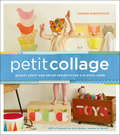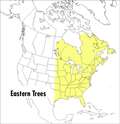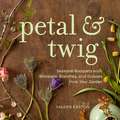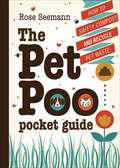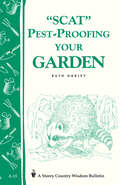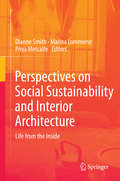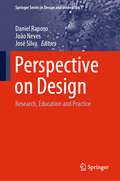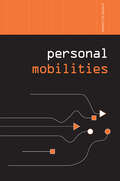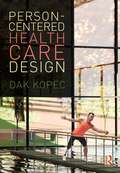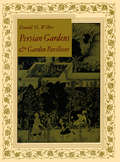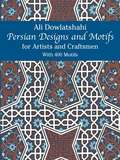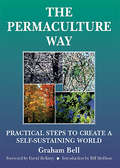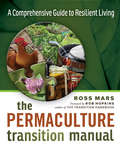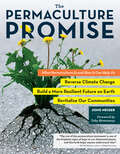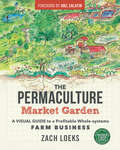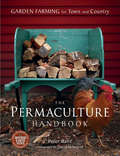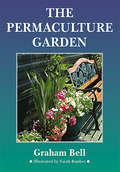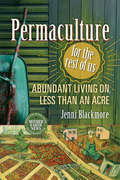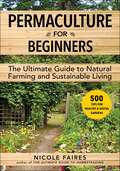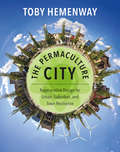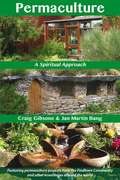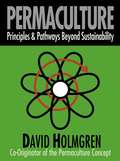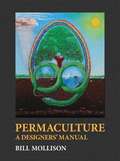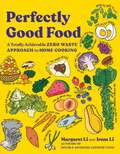- Table View
- List View
Petit Collage
by Lorena SiminovichFrom the beloved design brand for nurseries, playrooms, and every space in between, Petit Collage shows you how to make 25 of their bestselling paper and wooden accessories for your home. Customize toy chests, create cheerful name plaques, build bunny clocks, and more, with artist and owner Lorena Siminovich. Breaking down each project with simple, illustrated step-by-step instructions, Siminovich presents easy tips on how to personalize the Petit Collage signature style with your child's favorite colors and patterns. All you need are rubber stamps, paper, scissors, and the provided project templates to create a contemporary space filled with bright and distinctive décor. Whether you're looking for unique paper toys or vibrant namesake prints, Petit Collage's whimsical craft projects will inspire your children to put their little touch and big imagination into your family home.
A Peterson Field Guide To Eastern Trees: Eastern United States And Canada, Including The Midwest (Peterson Field Guides #Volume 11)
by George A. Petrides Janet WehrFind what you're looking for with Peterson Field Guides—their field-tested visual identification system is designed to help you differentiate thousands of unique species accurately every time. This field guide features detailed descriptions of 455 species of trees native to eastern North America, including the Midwest and the South. The 48 color plates, 11 black-and-white plates, and 26 text drawings show distinctive details needed for identification. Color photographs and 266 color range maps accompany the species descriptions.
Petal & Twig: Seasonal Bouquets with Blossoms, Branches, and Grasses from Your Garden
by Valerie EastonForcing flowers to stand up and do tricks is the old way of flower bouquets. That called for flying in blossoms from around the world. The new way is so much more DIY and all about what's happening in the garden right now--no matter the season. Petal & Twig is full of photographs and descriptions of wonderfully fresh combinations from garden-expert Valerie Easton's own garden. With an inviting and personal tone, Easton shows how to assemble floral combinations for color, for fragrance, to express the essence of the season, for the dinner table, for the kitchen, for the bookshelf. Inspiration, experimentation, and simple pleasure are the keys to the new bouquets.
The Pet Poo Pocket Guide: How to Safely Compost and Recycle Pet Waste
by Rose SeemannEighty-three million dogs and ninety-six million cats call the United States home. Dogs alone produce enough waste to fill more than 1,091 football fields 1 foot deep in a single year. Add billions of plastic pick-up bags to the mix and season well with tons of litter box waste. Scoop a hefty portion into local landfills and seal it tightly to ensure optimal methane production. Clearly, this is a recipe for disaster.Dog and cat owners who trash their pets' offerings daily are in denial about how much waste is produced and what happens to it. Those who want to make the responsible choice often turn to the internet, only to find misleading, confusing, and contradictory information. The Pet Poo Pocket Guide will help you reduce your pet's environmental paw print with: Best practices for cycling pet waste back to nature Suggestions on how to tailor your approach based on location, situation, weather, needs, or available time Instructions for using your composted pet waste safely to enrich your soil and nourish ornamental plantsWith recycling tactics clearly indicated as "easy," "moderate," or "demanding," The Pet Poo Pocket Guide offers something for everyone. This no-nonsense guide is a must-read for any pet owner who is concerned about the environmental impact of their best friend, and is seeking a safe and practical solution.Rose Seemann is the owner and operator of EnviroWagg, a company dedicated to collecting and composting canine waste into safe, nutrient-rich garden soil.
Pests of Landscape Trees and Shrubs (Second Edition)
by Steve H. Dreistadt Jack Kelly Clark Mary Louise FlintThis is the ultimate guide to managing landscape pests! With this manual in hand you will be able to diagnose and manage hundreds of insect, mite, weed, plant disease, and nematode pests. Inside you'll find updated information on how to use environmentally safe, ecologically based IPM methods; landscape designs that prevent pests; how to select resistant varieties; advice on the use of less-toxic pesticides such as botanicals, oils, and soaps; and tips on planting, irrigating, and other plant-care cultural activities that help in avoiding problems. Contains over one hundred pages of easy-to-use tree and shrub pest tables; invaluable in helping you identify common pest problems now on over 200 types of ornamental trees and shrubs. Includes 432 color photographs, 117 drawings and tables, references, glossary, and an index.
Pest-Proofing Your Garden: Storey's Country Wisdom Bulletin A-15 (Storey Country Wisdom Bulletin Ser.)
by Ruth HarleySince 1973, Storey's Country Wisdom Bulletins have offered practical, hands-on instructions designed to help readers master dozens of country living skills quickly and easily. There are now more than 170 titles in this series, and their remarkable popularity reflects the common desire of country and city dwellers alike to cultivate personal independence in everyday life.
Perspectives on Social Sustainability and Interior Architecture
by Dianne Smith Marina Lommerse Priya MetcalfeThis book argues that interior architects have a responsibility to practice their profession in collaborative ways that address the needs of communities and of to be the agents of social justice and cultural heritage. The book is divided into three sections, based on three pivotal themes -- community engagement, social justice and cultural heritage. Each section has chapters that put forward the principles of these themes, leading into a variety of fascinating case studies that illustrate how socially sustainable design is implemented in diverse communities across the world. The second section includes four concise case studies of community housing issues, including remote-area indigenous housing and housing for the homeless. The third section offers two extensively researched essays on design and cultural heritage -- a case study of the development of a redundant industrial site and a historical study of gendered domestic interiors. The book appeals to a wider audience than the design community alone and challenges mainstream interior design/interior architecture practitioners nationally and internationally to take a leading role in the field of socially responsible design. The issues raised by the authors are relevant for individuals, communities, government and non-government organisations, professionals and students. "In the twenty-first century we seem to have entered into a new world of knowledge discovery, where many of the most exciting insights come not from the authority of a traditional discipline, but from the dialogue that happens at the hubs and intersections of thought -- the arenas where different disciplines and approaches, different schools and habits of thinking, come together to collaborate and contend. This collection is a good example of this, and I hope the book will be widely read and its lessons learned and applied. " Tim Costello, Officer of the Order of Australia, Chief Executive, World Vision Australia.
Perspective on Design: Research, Education and Practice (Springer Series in Design and Innovation #1)
by Daniel Raposo João Neves José SilvaThis book presents the outcomes of recent endeavors that are expected to foster significant advances in the areas of communication design, fashion design, interior design, and product design, as well as overlapping areas. The fourteen chapters highlight carefully selected contributions presented during the 6th EIMAD conference, held on February 22–23, 2018 at the School of Applied Arts, Campus da Talagueira, in Castelo Branco, Portugal. They report on outstanding advances that offer new theoretical perspectives and practical research directions in design, and which are aimed at fostering communication in a global, digital world, while also addressing key individual and societal needs.
Personal Mobilities (Networked Cities Ser.)
by Aharon KellermanPersonal Mobilities provides a systematic study of personal movement focusing on the dimensions of space, individuals, societies and technologies. Kellerman examines a variety of personal mobilities, including air transportation, through several perspectives, examining the human need for movement, their anchoring within wider societal trends, commonalities and differences among mobility technologies and international differences. Although spatial mobility seems geographical by its very nature, the topic has been so far treated only partially, and mainly by sociologists. Personal Mobilities highlights geographical as well as sociological aspects and is the first book to focus solely on personal mobilities.
Person-Centered Health Care Design
by Dak KopecDisease, injury, or congenital disorders result in an inability to perform activities of daily living as effectively as others. Most of these activities take place within and are dependent upon the designed environment. This book presents the specialized area of person-centered health care design, which focuses on a person's design needs because of one or more health conditions and requires foundational knowledge pertaining to infection control, bio-physiology, neuroscience, and basic biomechanics. Whether the designer has engaged in person- or condition-centered design, this book examines the causes that bring about health conditions, such as autoimmune disorders, chronic lung disease, muscular dystrophy, and neurological disorders, and the effects these have on a person's quality of life. Over forty various heath conditions are discussed in relation to assorted building typologies—schools, group homes, rehabilitation and habilitation centers, and more—to identify design solutions for modifying each environment to best accommodate and support a person’s needs. Dak Kopec encourages readers to think critically and deductively about numerous health conditions and how to best design for them. This book provides students and practitioners a foundational framework that supports the promotion of health, safety, and welfare as they pertain to a person's physiological, psychological, and sociological well-being.
Persian Gardens & Garden Pavilions
by Donald N. WilberThis Persian gardening book showcases classic gardens and pavilions and presents gardening advice for the aspiring amateur landscaper looking to add an Eastern flair to his or her yard.The garden has always had a special meaning for Persian (Iran). <P><P>The Persian garden, with its flowing pools, fountains, waterways, rows of tall trees, rich arrays of fruit trees and flowers, and cool pavilions, has represented an image of paradise.Persian Gardens & Garden Pavilions is both a comprehensive survey and an appreciation of this Persian tradition of gardens and garden pavilions. The text traces the historical development of Persian gardens, describes their basic features, presents existing examples, and discusses the literature and tradition behind them. The 119 illustrations include detailed plans and photographs of surviving gardens and their pavilions made on the spot, as well as a comprehensive collection of paintings, lithographs, and drawings of the nineteenth century executed both by Persian artists and by European travelers and emissaries of the period.The author points out, the gardeners who read this book should come across many details and ideas that can be incorporated into their own kinds of gardens.
Persian Designs and Motifs for Artists and Craftsmen (Dover Pictorial Archive)
by Ali DowlatshahiOver the centuries, Persia (Iran) has borne the brunt of periodic invasions. Elements of these foreign cultures, including Greek, Arabic, Turkish, Mongolian, and European influences, were incorporated into the native artistic tradition but transmuted by Persian artists into a highly original and uniquely Iranian style. This outstanding collection of motifs comprises over 400 examples of this rich tradition, ready for use in a multitude of design areas.Ranging from prehistoric pottery painting to 20th-century calligraphy, this volume spans the full spectrum of Iranian art, including the Achaemenian, Parthian, Sassanian, and Safavid eras. Included are designs drawn from textiles (weaves, printed fabrics, embroidery, carpets), ceramics (pottery and tile), carved and incised work (stucco, stone, metal), miscellaneous ornament, book illustration, and calligraphy.The author, a native Iranian and well-known artist, has carefully rendered designs from original masterpieces in public and private collections around the world. The motifs include floral patterns, geometrics, arabesques, mythical creatures, rosettes, paisley patterns, palmettes, medallions, border and marginal decorations, scrolls, curves, and hunting scenes.Embodying the sumptuous detail, rich texture, and elaborate ornamentation that constitute the glory of Persian art, these motifs also exemplify the Iranian artist's traditional devotion to symmetry, harmonious pattern, and purity of line and form.
The Permaculture Way
by Graham BellThe Permaculture Way shows us how to consciously design a lifestyle which is low in environmental impact and highly productive. It demonstrates how to meet our needs, make the most of resources by minimizing waste and maximizing potential, and still leave the Earth richer than we found it.
The Permaculture Transition Manual: A Comprehensive Guide to Resilient Living
by Ross MarsCaught between climate change and a fossil fuel-driven economy that demands ever more growth, the world faces a great transition--by design or disaster--away from fossil fuels to a less energy intensive future. But what proven tools are available to aid in making a successful, deliberate transition to a resilient, sustainable future? For the first time, the power of permaculture design has been brought to bear on the great transition problem. In the process, acclaimed permaculture teacher and designer Ross Mars has distilled his considerable knowledge into the ultimate resource for resilient living. The Permaculture Transition Manual is packed with information on permaculture design principles, soil building, nutrient-dense food growing, including top plant and tree selections for all climatic zones. Coverage extends to rainwater harvesting and irrigation, human waste management, and strategies for rural properties plus a unique focus on applying permaculture to small urban spaces for decluttering and efficient food growing. Also covered are hand tools, food preservation, energy production, and low-carbon housing and a plethora of nearly forgotten skills such as soap making, basket weaving, seed saving, and rope and candle making, and more. On the desert island of a world in decline this is the one-stop guide to vibrant, resilient living you'll want to take with you. Ross Mars is a scientist with a PhD in Environmental Science, entrepreneur and highly-regarded permaculture teacher and designer. Author of The Basics of Permaculture Design, he manages Candlelight Farm, a permaculture demonstration site and training center in Western Australia.
The Permaculture Promise: What Permaculture Is and How It Can Help Us Reverse Climate Change, Build a More Resilient Future on Earth, and Revitalize Our Communities
by Toby Hemenway Jono NeigerPermaculture is a sustainability buzzword, but many people wonder what it actually means and why it is relevant. Originally coined by combining the words permanent and agriculture, permaculture has evolved into an optimistic approach connecting all the systems of human life: gardening, housing, transportation, energy, and how we structure our communities. The Permaculture Promise explains in simple terms why permaculture may be the key to unlocking a livable future on our planet. Author Jono Neiger asserts that humans can thrive while simultaneously making Earth healthier and not destroying it. The book shows 22 ways that permaculture can create a better future for all living things. Profiles of people and communities — including an urban dweller who tore up her driveway to create a vegetable garden and a California housing development that dedicates a third of its land to parks, orchards, and gardens — will inspire you to incorporate permaculture principles into your life today.
The Permaculture Market Garden: A Visual Guide to a Profitable Whole-systems Farm Business
by Zach LoeksAuthor Zach Loeks brings together his passion for sustainable permaculture food production systems and beautiful, vibrant illustrations to provide a highly visual guide to the smooth integration of permaculture into the market garden, without use of major equipment or operation changes. Profiling crops and ecosystem-based systems, Loeks demonstrates a profitable, sustainable and approachable model for the future of market gardening.
The Permaculture Handbook
by David Holmgren Peter BaneThe urban landscape has swallowed vast swaths of prime farmland across North America. Imagine how much more self-reliant our communities would be if thirty million acres of lawns were made productive again. Permaculture is a practical way to apply ecological design principles to food, housing, and energy systems, making growing fruits, vegetables, and livestock easier and more sustainable.The Permaculture Handbook is a step-by-step, beautifully illustrated guide to creating resilient and prosperous households and neighborhoods, complemented by extensive case studies of three successful farmsteads and market gardens. This comprehensive manual casts garden farming as both an economic opportunity and a strategy for living well with less money. It shows how, by mimicking the intelligence of nature and applying appropriate technologies such as solar and environmental design, permaculture can:*Create an abundance of fresh, nourishing local produce *Reduce dependence on expensive, polluting fossil fuels*Drought-proof our cities and countryside*Convert waste into wealthPermaculture is about working with the earth and with each other to repair the damage of industrial overreach and to enrich the living world that sustains us. The Permaculture Handbook is the definitive practical North American guide to this revolutionary practice, and is a must-read for anyone concerned about creating food security, resilience, and a legacy of abundance rather than depletion.Peter Bane is a permaculture teacher and site designer who has published and edited Permaculture Activist magazine for over twenty years. He helped create Earthaven Ecovillage in North Carolina, and is now pioneering suburban farming in Bloomington, Indiana.
The Permaculture Garden
by Graham BellWorking entirely in harmony with nature, The Permaculture Garden shows you how to turn a bare plot into a beautiful and productive garden. Learn how to plan your garden for easy access and minimum labor; save time and effort digging and weeding; recycle materials to save money; plan crop successions for year-round harvests; save energy and harvest water; and garden without chemicals by building up your soil and planting in beneficial communities. Full of practical ideas, this perennial classic, first published in 1995, is guaranteed to inspire, inform, and entertain.
Permaculture for the Rest of Us
by Jenni BlackmoreMany of us want to increase our self-sufficiency, but few have access to the ideal five sunny, gently sloping acres of rich, loamy, well-drained soil. Jenni Blackmore presents a highly entertaining, personal account of how permaculture can be practiced in adverse conditions, allowing anyone to learn to live more sustainably in a less-than-perfect world. With a rallying cry of "If we can do it, you can too," she distills the wisdom of twenty years of trial and error into a valuable teaching tool.The perfect antidote to dense, high-level technical manuals, Permaculture for the Rest of Us presents the fundamental principles of this sometimes confusing concept in a humorous, reader-friendly way. Each chapter focuses on a specific method or technique, interspersing straightforward explanations with the author's own experiences. Learn how to successfully retrofit even the smallest homestead using skills such as: No-till vs. till gardening, composting, and soil-building Natural pest control and integrating small livestock Basic greenhouse construction Harvesting, preservation, and moreIdeal for urban dreamers, suburbanites and country-dwellers alike, this inspirational and instructional "encouragement manual" is packed with vibrant photographs documenting the author's journey from adversity to abundance. Jenni Blackmore is a farmer, artist, writer and certified Permaculture Design Consultant who built her house on a rocky, windswept island off the coast of Nova Scotia almost twenty-five years ago and has been stumbling along the road to self-sufficient living ever since. A successful micro-farmer, she produces most of her family's meat, eggs, fruit, and vegetables, in spite of often-challenging conditions.
Permaculture for Beginners: The Ultimate Guide to Natural Farming and Sustainable Living
by Nicole FairesTake your garden to the next level—organic, native, and natural! Permaculture is an important but often misunderstood method of growing food and building homes in a manner that works with nature, rather than against it, to create beautiful, healthy, and useful gardens. Blending ecology, organic agriculture, green home design, appropriate technology, and biology can be confusing and overwhelming, but Permaculture for Beginners simplifies this vast field for practical application. This is a hands-on guide, taking the beginner through each step of the design process, so that anyone can apply permaculture principles to their own life. While the principles are simple, the in-depth topics cover every aspect of permaculture, including: Building green homes and passive solar design Growing edible plant communities and forest gardens Using no-till and natural farming methods Creating microclimates for extended growing seasons Raising livestock with ecological foraging techniques Transforming urban backyards into food-abundant oasesThis is a commonsense approach to sustainable living that creates a self-sufficient and low-effort home for the people that live there, whether in the city or the country. Permaculture for Beginners isn&’t a philosophy book, or a dissertation on theory. It is a step-by-step, complete guide to every aspect of permaculture.
The Permaculture City
by Toby HemenwayPermaculture is more than just the latest buzzword; it offers positive solutions for many of the environmental and social challenges confronting us. And nowhere are those remedies more needed and desired than in our cities. The Permaculture City provides a new way of thinking about urban living, with practical examples for creating abundant food, energy security, close-knit communities, local and meaningful livelihoods, and sustainable policies in our cities and towns. The same nature-based approach that works so beautifully for growing food--connecting the pieces of the landscape together in harmonious ways--applies perfectly to many of our other needs. Toby Hemenway, one of the leading practitioners and teachers of permaculture design, illuminates a new way forward through examples of edge-pushing innovations, along with a deeply holistic conceptual framework for our cities, towns, and suburbs. The Permaculture City begins in the garden but takes what we have learned there and applies it to a much broader range of human experience; we're not just gardening plants but people, neighborhoods, and even cultures. Hemenway lays out how permaculture design can help towndwellers solve the challenges of meeting our needs for food, water, shelter, energy, community, and livelihood in sustainable, resilient ways. Readers will find new information on designing the urban home garden and strategies for gardening in community, rethinking our water and energy systems, learning the difference between a "job" and a "livelihood," and the importance of placemaking and an empowered community. This important book documents the rise of a new sophistication, depth, and diversity in the approaches and thinking of permaculture designers and practitioners. Understanding nature can do more than improve how we grow, make, or consume things; it can also teach us how to cooperate, make decisions, and arrive at good solutions.
Permaculture: A Spiritual Approach
by Craig Gibsone Jan Martin BangPermaculture design as divine creative activity. Permaculture looks for the patterns embedded in our natural world as inspirations for designing solutions to the many challenges we are presented with today. It is a philosophical, spiritual and practical approach to the use of the land, integrating microclimate, functional plants, animals, soils, water management and human needs into intricately connected, highly productive systems. In essence, permaculture uses observation as basis for creating sustainable and effective human settlements. The authors discuss the components Earthshare, Fairshare and Peoplecare, with a specific emphasis on the spiritual aspects of the design process. Topics range from soil and plants, energy sources and house design to alternative economics, group process, governance, and spiritual nurturing and enquiry. Examples of existing permaculture structures from around the world, most notably from the Findhorn Community Eco-Village, bring the concepts to life. First-hand accounts of how people got started on their permaculture project lend a personal touch. The first book to look at the spiritual aspects as well as the practical implementation of permaculture design.
Permaculture: Principles and Pathways Beyond Sustainability
by David HolmgrenDavid Holmgren brings into sharper focus the powerful and still evolving Permaculture concept he pioneered with Bill Mollison in the 1970s. It draws together and integrates 25 years of thinking and teaching to reveal a whole new way of understanding and action behind a simple set of design principles. The 12 design principles are each represented by a positive action statement, an icon and a traditional proverb or two that captures the essence of each principle. Holmgren draws a correlation between every aspect of how we organize our lives, communities and landscapes and our ability to creatively adapt to the ecological realities that shape human destiny. For students and teachers of Permaculture this book provides something more fundamental and distilled than Mollison's encyclopedic Designers Manual. For the general reader it provides refreshing perspectives on a range of environmental issues and shows how permaculture is much more than just a system of gardening. For anyone seriously interested in understanding the foundations of sustainable design and culture, this book is essential reading. Although a book of ideas, the big picture is repeatedly grounded by reference to Holmgren's own place, Melliodora, and other practical examples.
Permaculture: A Designers' Manual
by Bill MollisonThis edition was compiled for teachers, students and designers as they master the art of assembling conceptual, material, and strategic components in a pattern which functions to benefit life in all its forms.
Perfectly Good Food: A Totally Achievable Zero Waste Approach To Home Cooking
by Margaret Li Irene LiA Food & Wine Best New Summer Cookbook A Book Riot Most Anticipated Cookbook of 2023 How to cook flexibly and fight food waste, with 80 recipes and 150 ideas to use up what you have. You’re standing in front of your refrigerator, a week after your last trip to the supermarket. You’ve got a bunch of random veggies, some wrinkly fruit, near-expired milk, and those pricey fresh herbs you bought for that one recipe and don’t know how to use up. For a split second you picture yourself opening a trash bag, throwing everything away, and ordering takeout. We’ve all been there. But instead…you pick up this cookbook. In no time you’ve prepared a Make-It-Your-Own Stir-Fry and How-You-Like-It Savory Pancakes, plus a Mix-and-Match Fruit Galette that you’ll have for dessert. Time to celebrate—you’re saving food, shrinking that grocery bill, and learning some key skills for making the most of what you have. It’s exciting to be able to create new dishes and waste less food, and most importantly—a delicious dinner is on the table! Perfectly Good Food is a book for those moments everyone has, whether you cook for one or a whole household—moments standing before an overfull pantry or near-empty fridge, not sure what to do with an abundance of summer tomatoes or the last of the droopy spinach. Chock-full of ingenious use-it-up tips, smart storage ideas, and infinitely adaptable recipes, this book will teach you why smoothies are your secret weapon; how to freeze (almost) anything; why using your senses in the kitchen (including common sense!) is more important than so-called shelf-life. Written by the chef-sisters behind Boston’s acclaimed Mei Mei Dumplings, this cookbook/field guide is a crucial resource for the thrifty chef, the environmentally mindful cook, and anyone looking to make the most of their ingredients.
